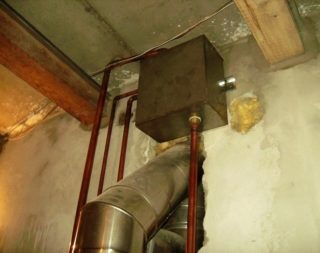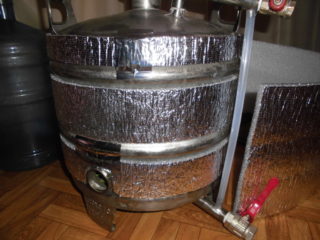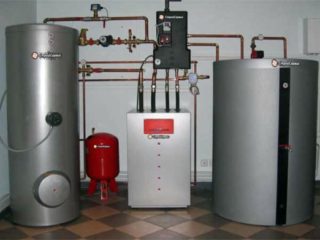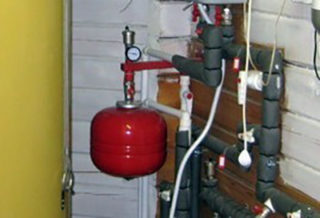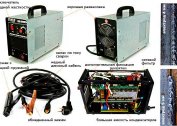Reliability, stability and long service life of any engineering networks are directly related to the correct calculation of the components. An expansion tank for heating is an important element in the design of air heating in a private house. There are no trifles in the selection and installation. Staying cold without heat means endangering your health and provoking damage to radiators and pipelines.
Device purpose
The physical properties of the liquid - to increase in volume when heated and the inability to compress at low pressure indicators - require the mandatory installation of expansion tanks in heating systems.
When heated from 10 to 100 degrees, water increases in volume by 4%, and glycol liquids (antifreezes) by 7%.
Heating built using a boiler, piping and radiators has a finite internal volume. The water heated in the boiler, increasing in volume, does not find a way out. The pressure in the pipes, radiator, heat exchanger rises to critical values, capable of breaking the structural elements, squeezing the gaskets.
Private heating systems can withstand up to 5 bar depending on the type of pipes and radiators. Safety valves in the safety groups or in the boiler protection equipment operate at 3 Atm. This pressure occurs when water is heated in a closed container to 110 degrees. Workers consider 1.5 - 2 Atm.
To accumulate excess coolant, expansion tanks are installed.
After cooling, the coolant volume returns to its previous values. To prevent airing of radiators, water is returned to the system.
All possible types of devices are divided into two classes: expansion tanks for heating indoor and outdoor.
Open type
Open type tanks for heating are most often used in gravity (gravity) systems.
Tank design
For self-production, you will need any capacity - a bucket, canister, a piece of large diameter pipe.
A hole is made in the bottom of the tank through which the tank is connected to the heating system via a supply pipe. In the upper part, a cover is installed through which the level of the coolant is controlled and, if necessary, topped up.
Do not leave the tank without a lid to avoid dust, insects and foreign objects getting into the water.
For convenience, an air valve is installed in the lid. In this case, they fill the system through a separate faucet from the water supply system - the valve releases air, but does not allow excess water to flow over the edge.
Mount the expansion tank at the highest point of the heating system. According to the principle of communicating vessels, the coolant does not leak from the tank.
For safety, the tank is equipped with an overflow hose with a outlet to the sewer or outside the house. If there is too much fluid, it will be diverted through the hose in safe mode and will not flood the room.
It is undesirable to use plastic containers, since the temperature of the water / antifreeze is close to 90 degrees or higher before it enters the radiators. The plastic will collapse, the coolant will pour into the room (in the attic).
Device operation
As the coolant is heated, it expands. Surplus is diverted to the expander. After cooling, the water returns to the piping and radiator system.
The tank communicates with the air, the excess of which is discharged into the room.
Device requirements
The tank design does not have big requirements. Fulfill two conditions:
- a sufficient volume of capacity is selected to ensure heating and cooling cycles;
- The tank must be in communication with the air.
The shape can be any, but it is undesirable for horizontal dimensions (width or diameter) to be larger than vertical (height). The larger the surface area, the more water evaporates when heated, therefore, it will be necessary to engage in monitoring and topping up more often.
For open systems, only water is chosen as the heat carrier. Alcohol and glycol additives quickly evaporate from heated antifreeze, which dramatically increases the cost of maintenance - the coolant will have to be regularly and often replenished. Chemically hazardous inhalation substances are often used as additives, which, upon evaporation, damage the health of residents.
Advantages and disadvantages

Advantages and disadvantages associated with the design and principle of operation of the device.
The positive properties include:
- the cheapness of the purchased device and the ability to make it yourself from improvised materials;
- simplicity of design, in which there are no additional mechanical elements (pumps, membranes);
- the ability to do without system alterations when replacing a gravity (gravity-fed) boiler with a forced circulation heater;
- autonomy of work;
At the same time, the use of gravity-fed systems and open expansion tanks is not always possible. Restrictions are imposed on the number of storeys of the building - not more than 6 - 7 meters from the bottom of the boiler to the upper level of the coolant in the tank.
The water level is subject to regular checks, including the summer period. With a lack of water, the circulation of the coolant will stop. Contact of the internal cavities of metal pipes and radiators causes oxidation or corrosion, which reduces the life of the heating. In addition, layers of rust create hydraulic resistance to the flow of water.
Do not use open heating systems if electrode boilers are used in the system that are demanding on the chemical composition of the coolant. As evaporation proceeds, the conductivity changes, which affects the performance of the water heater.
Volume calculation
To refuel the heating system, tap water is most often used. Its temperature does not change much throughout the year. On average, values tend to 13 degrees in winter and around 16-18 in summer. When heated from 10 to 90 degrees, water will add in a volume of 4.5%. Antifreeze will expand by 6-7.5% in volume.
Taking into account the need for a small supply, the volume of the expansion tank should be 10% of the total capacity of the boiler heat exchanger, pipelines and radiators.
You can approximately calculate the required volume in different ways. Do this at the design and purchase stage of materials.
The capacity of one section of the radiator is indicated in the product passport. The volume of coolant in one running meter of the pipe is calculated according to special tables. For example, 0.43 liters of water are placed in a meter of a steel pipe with a diameter of ¾ inch, and about 2.4 liters are placed in a 2-inch pipe. Having added the received data, receive approximate capacity of the heating system.
The second method is practical. The finished system, without a tank, is filled with water. The volume is obtained according to the meter or the number of buckets of water, if the filling is carried out manually.
Installation Requirements
An open expansion tank is installed at the highest point of the system. This is usually a second floor or attic.
In the first case, it is better to choose a non-residential premises - during heating, the coolant emits noise when moving through pipes, gurgling sounds sound unpleasant, especially at night. In addition, part of the water evaporates, increasing the humidity in the room.
When installing the tank in the attic, measures are taken to warm the tank. If this is not done, most of the heat (in the tank 10% of the coolant) will heat the air.
When the coolant is shut off, the uninsulated tank will cool quickly. After some time, the water will freeze. Even if there is no rupture of the tank, you will have to heat the supply pipes.
Provides quick access to the lid to check the level and top up the water.
Closed type
An expansion tank for closed-type heating is mounted in systems with forced circulation of the coolant.
Design Advantages:
- tightness - water (antifreeze) does not boil, and cannot pour out indoors;
- installation in any section of the pipeline;
- non-freezing liquid can be poured into the system, which excludes defrosting during emergency blackouts of energy carriers;
- control of the state of the coolant for devices;
- lack of contact with air and a lower rate of spread of corrosion.
Sealed models are more expensive than open options, but in the general estimate for the heating system, the cost takes a small part.
The tightness of the structure does not allow "excess" water to leak, so the pressure can reach critical values. In this regard, when installing closed expansion tanks, a safety group is necessarily mounted, which also increases costs.
Design options
The performance of the tanks may vary, but the principle remains the same everywhere.
The body is made by stamping from durable metal. The inside is coated with an anti-corrosion compound.
The tank is divided into air and working cavities by an elastic, chemically resistant membrane.
On sale there are tanks of blue and red colors. Blue products are intended for water supply. It is not allowed to use them for heating, since the membranes are not designed for high temperatures. For heating, only red tanks are purchased.
A threaded pipe is welded into the bottom of the body for connection to the pipeline.
A nipple with a spool is installed on the opposite side. Through it, until the system is filled, a pressure of 1 - 1.5 Atm is created in the air cavity. This is necessary for starting boilers with automation.
The main part is an elastic butyl or ethylene propylene membrane that divides the tank into two cavities.
As it is heated, the coolant is squeezed out into the working chamber of the tank. The membrane gasket is deformed, the air is compressed, while increasing pressure. If the pressure in the system exceeds 3 - 3.5 Atm, the safety group will work by venting some of the excess liquid. On some models, a safety valve is already integrated at the time of manufacture.
When the water cools, the pressure decreases, the coolant flows from the tank into the pipeline.
Mounting Features
Installing the tank in the system or replacing (repairing) will not be difficult even for a master with small plumbing skills.
A set of tools and accessories will need a minimum:
- spanners;
- winding on the thread according to the preferences of the master (linen, fum);
- thread adapters (if necessary);
- bracket for attaching the tank to the wall.
Prior to installation, an audit of the available material assets is carried out and they purchase the necessary.
Installation Requirements:
- The tightness of the tank allows you to install it anywhere, but preference is given to the section of the return pipe at the very entrance to the boiler.In this place, the temperature of the coolant is about 40-50 degrees (at the exit from the boiler 90 - 100), which will extend the life of the membrane.
- The circulation pump is positioned closer to the boiler so as not to create turbulence in the water.
- The tank is connected via a quick-disconnect connection (American) so that it can be quickly dismantled for repair or replacement.
- A ball valve is mounted in front of the tank (before the American woman), by shutting off which the tank can be removed without draining the coolant from the entire system.
- The tank must be attached to a solid base of the wall, for this there is a mounting bracket in the kit and the clamp must be of a diameter. Without reliable fastening, when filling with coolant, the tank mass can reach 20–30 kg, which can damage the supply pipes.
After installation, you can check the system in action.
An expansion tank is an indispensable component of heating systems, from which they come from the design features, choosing one or another type of reserve capacity. Installation is simple and does not require configuration, subject to important installation requirements.

